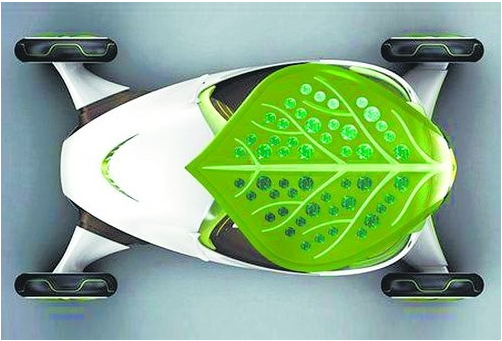(单词翻译:单击)

Science and technology.
科技。
Carbon capture and storage.
碳的收集和储存。
A shiny new pipe dream.
闪亮的管子 崭新的梦想。
Capturing the carbon dioxide from power stations is not hard. But it is. expensive. A new project in Norway aims to make it cheaper
从发电站收集二氧化碳不难,但花费很高。挪威的一个新项目旨在降低碳捕捉的成本。
AS Helene Boksle, one of Norway's favourite singers, hit the high notes at the Mongstad oil refinery on May 7th, the wall behind her slid open. It revealed, to the prime minister and other dignitaries present, an enormous tangle of shiny metal pipes. These are part of the world's largest and newest experimental facility for capturing carbon dioxide.
五月七日挪威最受欢迎的歌手Helene Boksle 在蒙斯塔德炼油厂引吭高歌,她身后的大幕缓缓打开。首相和其他政要现身,一个巨大闪亮的金属管网也映入观众的视线。这是世界上最大最新的收集二氧化碳的试验装置的一部分。
Such capture is the first part of a three-stage process known as carbon capture and storage (CCS) that many people hope will help deal with the problem of man-made climate change. The other two are piping the captured gas towards a place underground where the rocks will trap it, and then actually trapping it there. If the world is to continue burning fossil fuels while avoiding the consequences, then it will need a lot of CCS. There is no other good way to keep the CO2 emitted by power stations, and also by processes such as iron- and cement-making, out of the atmosphere. To stop global warming of more than 2°C-a widely agreed safe limit-carbon-dioxide emissions must be halved by 2050. According to the International Energy Agency, an intergovernmental body that monitors these matters, CCS would be the cheapest way to manage about a fifth of that reduction.
很多人希望用三个阶段的这种碳收集储存(CCS)来应付人为的气候变化问题,这种收集是第一部分。其他两个部分用管道会把收集到的气体引入地下由岩石吸收,实际上接下来气体会被隔离在岩石里。如果人类继续燃烧矿物燃料并且避免其不利影响,将用到很多的CCS。没有其他的好办法来保存发电厂、钢铁厂和水泥厂排放到大气层的二氧化碳。为了阻止全球变暖超过2℃(被广泛认可的安全指标),必须在2050年以前把二氧化碳的排放量降低一半。按照国际能源署(监督这些事项的国际政府间组织)的说法,CCS能用最便宜的方式在降低碳排放中做出两成的贡献。
To do this, the agency reckons, requires the building of 100 capture facilities by 2020 and 3,000 by 2050. Which is a problem, because at the moment there are only eight, none of which is attached to a power station. Another 28, mostly in North America, are under construction or planned. But some are likely to be cancelled-as happened on May 1st to a project in Alberta. CCS is thus having difficulty reaching escape velocity.
为实现目标,国际能源署呼吁要在2020年以前建造100座收集装置,在2050年之前要建造3000座收集装置。这就是问题所在,因为目前只有八座,而且没有一座装置是联接发电厂的。其他28座装置大部分在北美,有的处于施工阶段,有的还在计划中。很有可能取消一些装置的建造,因为五月一日在亚伯达的一项工程中发现CCS在达到脱离速度方面存在难度。
That is not because it is hard. Since 1996, for example, Statoil, Norway's largest oil company, has captured and stored the CO2 which forms part of the natural gas extracted from the Sleipner field in the North Sea. Rather, the process consumes a lot of power that would not otherwise have to be generated-which is ironic, and also makes it expensive. Hence the need for experiments like those at Mongstad, to try to improve and cheapen it.
这些并不是因为难度问题。比如自从1996年以来,挪威最大的石油公司(挪威国家石油公司)就从北海的斯莱普内尔气田开采的天然气里收集并储存二氧化碳。但是有讽刺意味的是这个过程成本高昂并且会消耗大量能源。因此需要做类似蒙斯塔的试验,做出改进,降低消耗。
Burying bad news
隐瞒坏消息
The most common capture technologies involve running the gas to be processed through a solution of amines or ammonium carbonate. These react with CO2 to form soluble chemicals called carbamates and bicarbonates. The remainder of the exhaust (mostly nitrogen) can then be vented safely to the atmosphere. The carbon-rich solution, meanwhile, is treated in a separate vessel to release its burden of CO2, which can then be piped away and stored, and the amines or ammonium carbonate thus liberated recycled.
最普通的收集技术是用胺类溶液或者碳酸铵处理这些气体。这些物质和二氧化碳发生反应生成氨基甲酸盐和碳酸氢盐(都是可溶的)。废气的剩余物(大部分是氮)可以安全地排到大气。与此同时,在单独的容器中处理含碳丰富的溶液,将其负载的二氧化碳释放,用管子排走并储存起来,离析的胺或碳酸铵可以被循环利用。
All of which is fine and dandy except that, if rigged to the average coal-fired power station, this process might use a quarter of the energy the plant produces. According to Howard Herzog, a chemical engineer at the Massachusetts Institute of Technology who has made a study of the matter, that implies a cost of between $50 and $100 per tonne of carbon stored. Carbon dioxide can sometimes be sold to oil companies for injection into partially depleted wells, in order to force more petroleum out of them. For that use it fetches at most $40 a tonne. But much CO2 is not produced near depleted oil wells-and anyway, the price would surely drop if CCS became widespread. In one way or another, then, the technology will need to be subsidised if it is ever to become important.
如果普通的烧煤发电厂使用这些被赋予美好愿望的先进技术,这个过程会消耗电厂产生的四分之一的能源。麻省理工学院的化学工程师霍华德·赫佐格研究过这个事情,他说这意味着每储存一吨碳的成本在50到100美元之间。有时候可以把二氧化碳卖给石油公司,他们用来注入部分耗尽的油井,这样就能出更多的石油。每吨最多能卖到40美元。但是在这些将近开采殆尽的油井的周围不能生产更多的二氧化碳,总之一旦广泛采用CCS技术,这个价格一定会降下来。如果这项技术的重要性要得到提高,必须对其进行资助。
There was a rush of interest in CCS in the late 2000s, including $3 billion for it in America's stimulus package of 2009. But many projects are now being cancelled. Either the developers have lost confidence in government commitments to support them or their costs have turned out higher than expected. Mongstad-a billion-dollar development owned jointly by the Norwegian government and three oil companies, Statoil, Shell and Sasol of South Africa-is a rare exception that has actually opened. Hence the hoopla.
二十世纪末,有一阵子人们对CCS感兴趣,2009年美国曾对其直接投入三十亿美元。但是很多工程现在被取消了。不是支持工程的开发商对政府的承诺失去信心就是成本超出预期。蒙斯塔出人意料地联合挪威政府和三家石油公司( 挪威国家石油公司、壳牌和南非的萨索尔)开发的价值十亿美元的项目已经正式开工。关于CCS的争论更加激烈。
The facility itself consists of two capture plants fitted with more than 4,000 instruments to monitor what is going on, and with a total capacity of 80,000 tonnes of carbon a year. These plants are connected to the exhaust flues of the refinery and also to a nearby gas-fired power station. That lets operators experiment with different flow rates and carbon-dioxide concentrations, which can be tweaked to be anything from 3.5% to 14% (roughly equivalent to those from a coal-fired power station).
这个装置本身包括装配着两个收集设备,这两个设备里面安置了四千个用来监控设备运行的仪表,每年能收集八万吨碳。这些设备和炼油厂的废气管相连,而且附近就是一座燃烧天然气的发电站。操作人员可以用不同的流速和二氧化碳浓度进行试验,这些参数可以从3-5%调整到14%(和烧煤发电厂的大致一样)。
The operators will also experiment with the capture technology itself. At one of the two plants Aker Clean Carbon, a Norwegian firm, will have 14 months to try out a new amine solution. At the other Alstom, a French concern, has 18 months to test the ammonium-carbonate process.
操作人员也可以用设备本身的收集技术做试验。一家叫阿克清洁碳的挪威公司在其中的一台设备上用了十四个月的时间提炼出一种新的胺溶液。另一家法国公司阿尔斯通则用十八个月的时间测试碳酸铵工艺。
Amine- and ammonium-carbonate-based CCS are not, however, the only ways to do things. Two other techniques, called gasification and oxy-combustion, work by reacting coal with pure oxygen rather than air, and thus produce exhausts that require little treatment before burial. The former uses coal, oxygen and steam to produce burnable hydrogen. The latter burns coal directly. Purifying oxygen and raising steam, however, both consume energy. And gasification also requires bespoke plants. Unlike the other processes it cannot be retrofitted to existing power stations.
然而,基于胺和碳酸铵反应的CCS并不是唯一的方法。其他两种叫做气化和富氧燃烧的技术,用纯氧气而不是空气烧煤,这样产生的废气在掩埋之前几乎不用处理。以前用煤、氧气和蒸汽生产可燃氢气。以后可以直接烧煤。提纯氧气提升蒸汽都要消耗能量。气化也要专门的设备。不像其他的工艺,没有必要为了现有的发电厂对其实施改造。
The upshot is that there is no free lunch. If people are serious about carbon capture and storage, they will have to pay for it. The best that facilities like Mongstad can do is make the meal as cheap as possible.
天下没有免费的午餐。如果人们要认真对待碳的收集和储存,他们需要为此埋单。蒙斯塔德的设备是最好的,能让这顿大餐最省钱。


